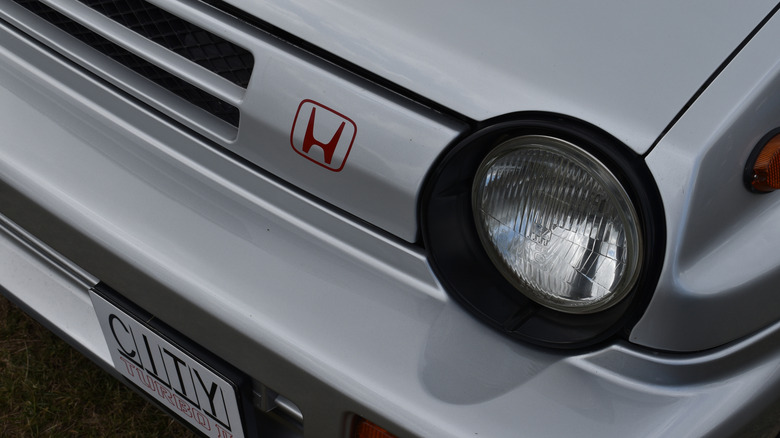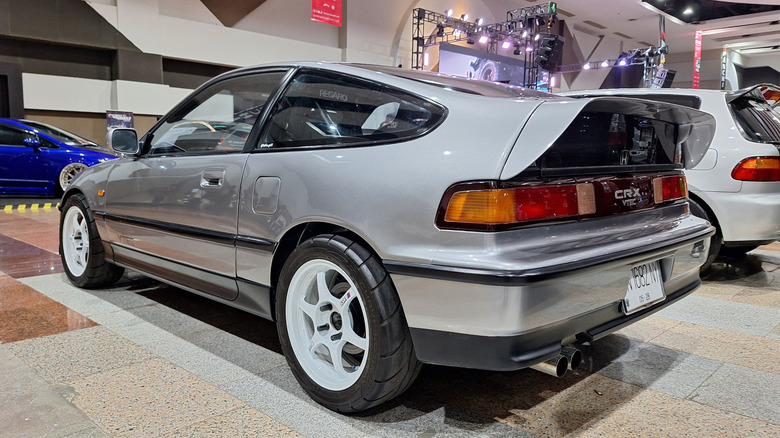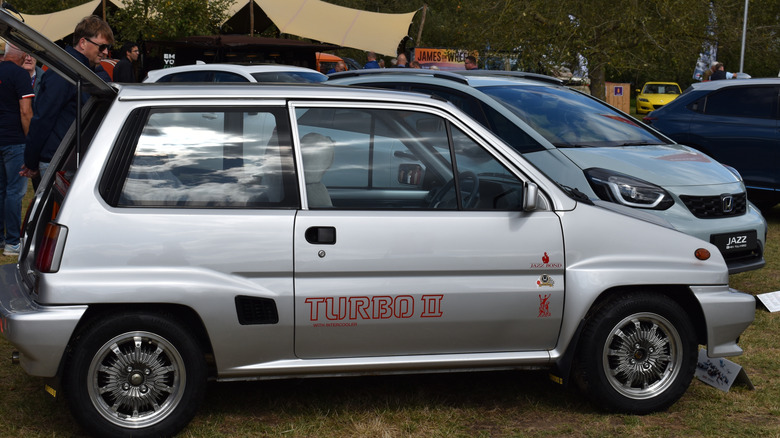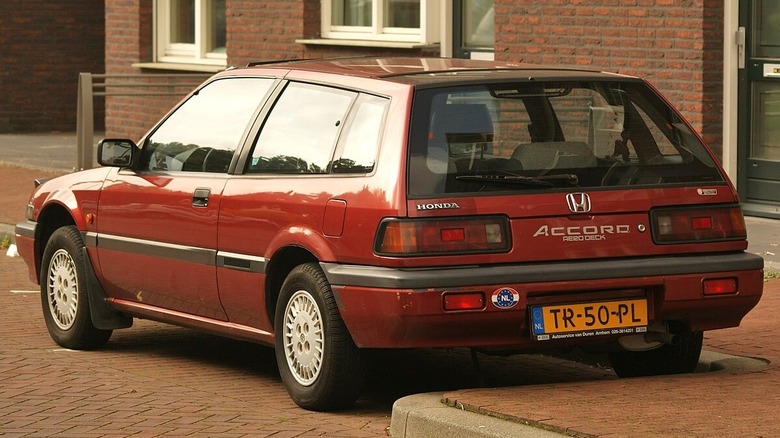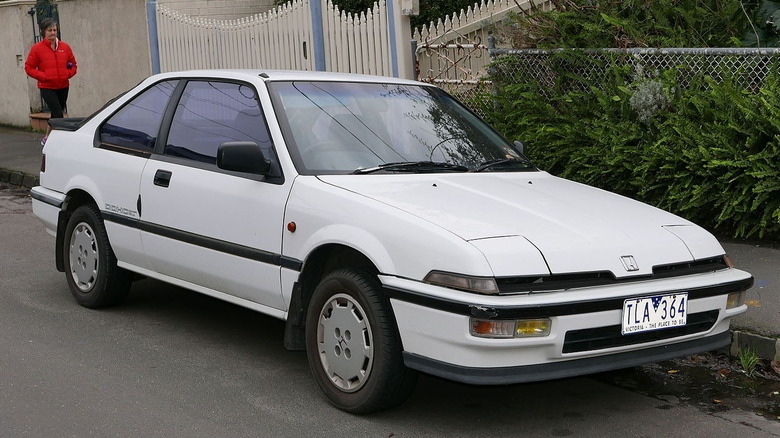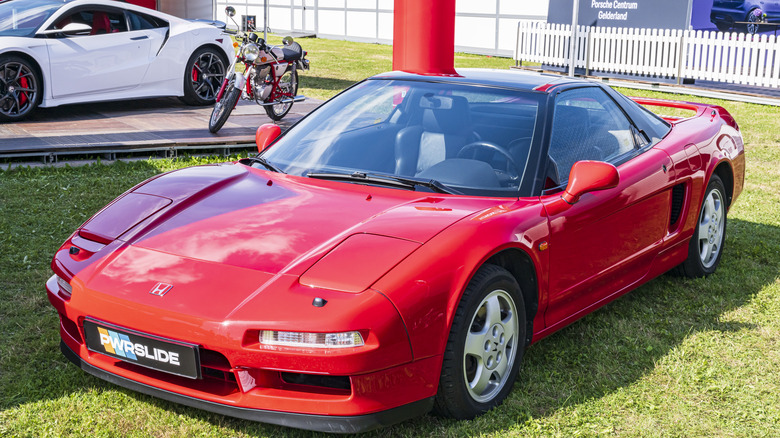5 Of The Coolest Honda Cars From The 1980s
Honda is a multinational monolith these days, but that wasn't always the case. From humble beginnings as a motorcycle producer in post-war Japan, through the introduction of its first passenger car, and on to achieving its place among the world's great automakers, the motor company founded by Soichiro Honda has undergone tremendous change. And so have its cars.
Incorporated in 1948, Honda's story spans the latter half of the 20th century, and its products reflect the times in which they were designed, stylistically and technologically. And few decades are more distinctive than the 1980s. The automotive aesthetics of the time could be questionable. There's no doubt a few impossibly ugly (not to mention poorly built) vehicles hit the streets during that time. However, the period proved to be a pivotal one for Honda. Nearly a half-century later, its unique and endearing 1980s designs have settled into beloved positions in the pantheon of automotive history. In honor of the decade that brought us MTV and the artificial heart, here are five of the coolest Honda cars from the 1980s.
CRX
The world first heard of the diminutive and sporty CRX when Honda unveiled the hot hatch in June 1983. Built on the versatile Civic platform, the buzzy two-seater called back to the S500, S600, and S800 models Honda produced in the 1960s.But this was a new age, and the CRX was no Sunday drive convertible.
The two-door was an aggressive wedge with a Kammback rear end that emulated cars like the Ford GT40 and the Ferrari 250 GT. That'll likely be the only time you hear it in the same breath as those legends, but that doesn't mean it doesn't deserve some love. Rather than a supercar killer, the CRX was an accessible, affordable, and undeniably fun offering that real people could enjoy.
The car swept through the 1980s in a tangle of confusing names. The Civic and Del Sol were closely associated with the CRX, and it even earned Honda's burgeoning Si badge. The CRX was a stepping stone to faster and furiouser, and it more than served its purpose. Its legacy and uniquely boxy design make it not only cool but a distinct stage of Honda's evolution from scooters to supercars. These days, it's immortalized in video games and the garages of amateur tuners.
City Turbo II
No list of cool Hondas is complete without a representation from its stable of iconic JDM cars. The City Turbo II might not have screamed neon-soaked street races, but today it's a quirky example of how unique can become cool with a few decades of hindsight.
The City was not just another urban commuter. It was a unique blend of economy and performance. Introduced at the Tokyo Motor Show in 1981, it initially came in two flavors: The E (for economy) trim and a racier R model. Hirotoshi Honda, the visionary at Mugen Motorsports (and also the son of Honda founder Soichiro Honda), played a pivotal role in its development, adding electronic fuel injection and a turbocharger along with upgraded brakes, wider wheels, and aesthetic flourishes.
The company quickly recognized the potential of Mugen's modifications, and the City Turbo II made its debut at the 1982 Tokyo Auto Show. Tiny but pugnacious-looking, the squat hatchback had a footprint roughly analogous to that of a matchbook — all the better to navigate crowded Japanese streets. And if that truckload of live chickens blocked the alley, drivers could jet the rest of the way on the included Honda Motocompo, a 2.5 hp 49cc scooter that lived in the trunk.
Accord Aerodeck
The Honda Accord has been described in many ways over the years. It has a well-earned reputation for staid reliability and safety — fantastic attributes in a car, but not necessarily cool ones. The Accord Aerodeck, however, broke the mold.
Everyone was experimenting in the '80s, and Honda took its Accord, which had been steadily climbing sales charts since its 1976 introduction, and turned it into the coolest of all vehicle types: the shooting brake. If you're wracking your brain trying to remember an Accord shooting brake, you may be from North America. Honda filed patents related to the design in the United States, but never brought it to market there.
Those blessed to live in a market where it was sold got a Kammback wagon with a transverse four-cylinder engine that could make as much as 122 hp. It was hardly a performance powerhouse, but that wasn't the point. Honda engineers sought to find the ideal balance of performance, practicality, efficiency, and fun in the Aerodeck. It may not have upended the entire auto industry as we know it, but forty years on, it retains a distinctly anachronistic-in-all-the-right-ways charm that makes it one of the coolest footnotes in auto history.
Integra
The Integra was fast and furious before Paul Walker had his driver's license. With Honda determined to improve its performance standing throughout the '80s, the Integra was the seed that sprouted into legendary nameplates, including the S2000, NSX, and various Type Rs.
The Integra debuted in 1985 as a replacement for Honda's oft-forgotten Quint. Light, with handling that delivered on what its sporty design promised, the Honda — Acura in North America — appealed to those looking for a moddable and spritely two-door. Part of its charm can be attributed to MacPherson struts and a double-wishbone suspension that made it a road-course weekend warrior to be reckoned with. It was new, quick, and perhaps best of all, accessible.
There may not be a replacement for displacement, but the buzzy 1.6-liter four-cylinder engine made a respectable 113 hp in the oil-starved '80s. By contrast, the 1985 Camaro produced 155 hp, with a 305 cubic inch V8! The weight savings in the engine alone closed some of the power gap while also saving money at the gas pump. The first-gen Integra closed out the '80s. The second-generation model debuted in 1990, marking the next chapter in a story that forever changed street racing and hot rod culture.
NSX
We know what you're thinking. The NSX was introduced in the '90s and sold under the Acura banner — how does it make a list like this? Firstly, it's a Honda product through and through, and it was sold in many markets bearing the familiar Honda logo. Secondly, the NSX made its public debut at the 1989 Chicago Auto Show, meaning that the first generation was primarily designed and built during the 1980s
The NSX is perhaps the coolest production car Honda has ever come up with. It was billed (and more importantly, competed) as a legitimate Ferrari fighter, and you aren't cool in the car world until you've beaten Ferrari — just ask Ford. Part of the reason for its success was a 3.0-liter, 24-valve VTEC engine that produced 270 hp. Influenced by the sleek lines of the F-16 Fighting Falcon, the original NSX is still a head-turner. It's got just enough '80s verve, in an elegant profile replete with pop-up headlights to call to mind the decade of Devo.
Cars that cut the bleeding edge of performance tend to be finicky, but the NSX bucked that trend. Supercar performance with Honda reliability? We'll take two. Just kidding — a first-gen NSX demands an average of nearly $80,000 on the used market. The NSX-R, which debuted in 1992, ups that figure to north of $390,000. If the rising prices on these cars weren't enough to convince you of their fabulousness, founder Soichiro Honda was able to see how far his company had come before he passed away in 1991. How cool is that?
